Yes, Tin Lizzie Was An Alcoholic
Every now and then I post articles by others. This is one of those times. Marc Rauch is a fellow journalist and member of the Western Automotive Journalists. He is also the Executive V.P and Co-Publisher of The Auto Channel (https://www.theautochannel.com/) where you'll find lots of good stuff to read.
Yes, Tin Lizzie Was An Alcoholic
Correcting Bad Revisionist History About Ford's Model T Automobile
By Marc J. Rauch
Exec. Vice President/Co-Publisher
THE AUTO CHANNEL
Exec. Vice President/Co-Publisher
THE AUTO CHANNEL
 Marc Rauch |
A part of the Model T's ubiquitous appeal to people around the world (even if it was not openly advertised as such) was that it was designed to run on different fuels, something that several other automobiles of the day were capable of doing (I purposely differentiate between "designed for," and "capable of").1
In today's terminology this multiple fuel feature is closer to what we call "flex fuel" or what the Brazilians call "total fuel" because they have blends all the way up to E100. But in those days they didn't have a word or abbreviated term for it. One of the reasons for this is that the words "gasoline," "gas," or "petrol" and "motor spirit" (in the UK regions) weren't set in stone like they have been for the past 50 years or so. They were often used generically to simply mean whatever "fuel," was being used to power an internal combustion engine.2 The word "gas" itself was mistakenly used as the usual colloquial word for gasoline (gas is defined as "a substance in a form like air that is neither solid nor liquid," whereas gasoline is very definitely a liquid). The same can be said for the UK's "petrol," which for at least six decades meant both a petroleum based engine fuel without ethanol, and petroleum based engine fuel with ethanol in it. Keep in mind that gasoline is not a single natural or manufactured substance, it is comprised of many ingredients, and especially during the early days of the automobile there was a very relaxed uniformity of product in different regions and between different brands (even the word "gasoline" wasn't spelled uniformly, it was sometimes spelled gasolene, and sometimes gassolene. The significance of this misuse of words and definitions will become obvious shortly.
The Model T's notoriety for being designed as a multi-fuel vehicle has long been recognized by a great many people for a what seems to me to be forever - at least since the 1970's. For example, here's what is said on the street about the Model T being a multi-fuel vehicle:
• In a 1998 white paper released in concert with the U.S. National Renewable Energy Laboratory, the document provides background information in which they state, "Henry Ford was the first American automobile manufacturer to see the potential of ethanol as a fuel in the early 1900s. Many of his early...automobiles were capable of operating on ethanol fuel rather than gasoline."
• Jeffrey and Adrian Goettemoeller's 2007 book SUSTAINABLE ETHANOL contains the following passage on page 12: "In 1908, Henry Ford equipped his Model T with engines capable of running on ethanol, gasoline, or a combination of the two."
• In 2008, Andrew English, Motoring Correspondent for The Telegraph publications wrote a story celebrating the centennial of the Model T and he stated "It was originally designed to run on bio ethanol."
• On the webpage of the U.S. government's Energy Information Administration website, headlined BIOFUELS: ETHANOL AND BIODIESEL EXPLAINED, it states: "In 1908, Henry Ford designed his Model T, a very early automobile, to run on a mixture of gasoline and alcohol. Ford called this mixture the 'fuel of the future'."
• In 2008, this is how Thomas Quinn, CEO of E-Fuel Corporation, described Henry Ford's multi-fuel Model T:
• The United States History for Kids website states, "Henry Ford and Model T Fact 19... The cars were flexible as to the quality or type of fuel it used...The engine was capable of running on gasoline, kerosene, or ethanol."
• On the Historic Vehicles Association website, they state that "Henry Ford produced the Model T. As a flexible fuel vehicle, it could run on ethanol, gasoline, or a combination of the two."
• In January 2011, Consumer Reports published a report on their website about ethanol. Their comments were right to the point: "The idea of running cars on ethanol is not new. Henry Ford designed the first Model T to run on ethanol so that farmers could produce their own fuel."
• Cole Gustafson, a biofuels economist at North Dakota State University in Fargo, N.D., stated "Ethanol...fueled Henry Ford’s Model T in 1908."
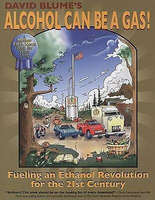 |
• The History Channel states that the Model T "...could go as fast as 40 miles per hour and could run on gasoline or hemp-based fuel." 3
• The ZME Science website describes the Tin Lizzie like this: "The Model T could also run on gas, grain alcohol, or ethanol. Farmers could easily distill their own fuel and use Ford’s vehicle as they pleased, without having to depend on gas supply which was rather scarce."
• In 2017, JEFF Zurschmeide wrote an article for EngineLabs website titled, HISTORIC ENGINES – THE FORD MODEL T. He wrote, "Because of the extremely basic design of the Model T engine, owners could run the car on gasoline, kerosene, or grain alcohol (pure ethanol). This “multifuel” capability was also done by design, to allow farmers to create their own fuel with excess corn. You can literally run a Model T on Moonshine!"
• On the FordModelT.net website of Australian automotive writer Mitch Taylor, he writes "The engine was capable of running on petrol, kerosene, or ethanol..."
• And, just a few months ago, in December 2018, automotive historian Jon Branch published a story about the Model T in which he wrote, "The engine was made so it could use fuels in common use in rural areas. Kerosene was a common fuel for farm tractors and stationary engines, ethanol was a home grown alcohol which was moderately popular until it became unavailable with the advent of the Prohibition era in 1919. So Prohibition didn’t just prevent human beings from drinking alcohol, it stopped Fords from drinking it too."
THE DISBELIEVERS
With statements like the ones I just presented, it's hard to believe that anyone would doubt that Henry Ford built the Model T to be a multi-fuel car, yet the disbelievers are there.
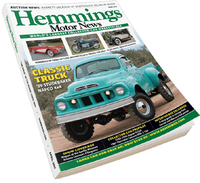 |
In the years since the advent of the World Wide Web and websites, Hemmings has added lots of personal and historic content so it's not just a classified ads periodical. Maybe they had some historical commentary back then, but I don't recall any, I was in it for the mouth watering ads. Naturally, I can easily understand why they would add in other content for their website; it makes perfect sense to support their position as the leading marketplace outlet of its kind. What I don't understand, however, is why they would take the position they did with the Model T.
In a story written by Daniel Strohl, "Fact Check: Henry Ford didn’t design the Model T as a multi-fuel vehicle," Mr. Strohl lays out why he and Hemmings feel that the Model T was not designed to run on any fuel other than gasoline. I'll be breaking their story down in a moment, but their position, I think, is simply encapsulated in the last sentence of the first paragraph: "...we’ve found no evidence that Ford designed the Model T to run on any fuel other than gasoline." This story was published on the Hemmings' website on April 23, 2017, almost exactly two years ago.
This Hemmings' story has led other individuals and entities to accept the conclusion that the Model T was not a multi-fuel vehicle. One such entity is a website called GREEN CAR REPORTS (not to be confused with the older, more established and credible entity GREEN CAR JOURNAL). The Green Car Reports story is titled "Alt-fuel history: Ford Model T wasn't designed for multiple fuels, really." It was written by Sean Szymkowski, and was published online five days after the Hemmings Motor News story. Mr. Szymkowski's opinion can be summed up with the two sentences: "Even those old-timers who have owned a Model T will likely rattle off a laundry list of fuels used, but Hemmings Motor News has utterly debunked the myth once and for all. After a bit of research, it turns out there is no conclusive evidence to affirm the Model T was meant to run on such fuels as ethanol or kerosene."
Without giving away too much at this point (because I want to share with you the bytes of research that I did on this subject), I wonder if the Hemmings' story wasn't really meant to be published three weeks earlier on April Fools Day in 2017 - it's pretty much on the level of being a prank. If you are not familiar with the words "bit" and "byte" in digital terms you may wish to look them up to understand how I've used them.
The Hemmings story bases its conclusions on these points:
1. That the truth about the Model T is obfuscated by the century-plus worth of legends that have accumulated around the vehicle, and after researching the matter, they found no evidence that Ford designed the Model T to run on any fuel other than gasoline.
2. That legends claim Ford incorporated a device on the dashboard of the Model T to facilitate switching, at will, from gasoline to ethanol, but that such a device does not exist.
3. That comments made by Henry Ford (or attributed to Henry Ford) predicting the importance of ethanol in the future, were not made by Ford until a decade or two after the introduction of the Model T. The most famous quote that Hemmings claims to have debunked is the one in which Ford is said to have said "Ethanol is the fuel of the future."
4. That the Model T couldn't have been a multi-fuel car because it didn't use one single carburetor designed to accommodate gasoline and any other fuel - that it used "no less than 13 different carburetors from at least four different manufacturers" over a period of 19 years. What's more, Hemmings states that Bruce McCalley in his exhaustive book MODEL T FORD: THE CAR THAT CHANGED THE WORLD, never mentions even one carburetor that was designed to run on anything other than gasoline nor does he mention any sort of switch or secondary fuel tank designed for running the Model T on a second fuel source. The Hemmings author goes on to say that they were able to confirm this point by examining the 1915 Model T they have in their own in-house display.
5. That the Model T carburetor’s needle valve was simply "to adjust the air-fuel ratio to compensate for ambient air temperature (or altitude or air density)," and not to magically allow it to run on ethanol.
6. That even if the Model T was capable of running on a fuel other than gasoline that it doesn't mean it was 'designed' to run on that gasoline.
As sort of a bonus, Hemmings throws in comments about John D. Rockefeller's involvement with getting alcohol banned in America (Prohibition), but they claim a previous Hemmings' story already debunked this issue. I'll be addressing this point later in my debunking the debunking comments.
 |
I understand that a publication or an individual can take one position one day, and then reverse position the next day after learning some contrary, more accurate information. However, if the change is based on newer/better/truer information, then the author should make sure that the new information really is better and truer - not just newer. There should be some explanation of how and why the change was made. When Kurt Ernst wrote his story in 2013, he must have researched the subject - at least a 'bit.' As of the day of publishing this story that you are reading now, there is no disclaimer or notification of any kind on either Mr. Ernst's 2013 story or Mr. Strohl's 2017 story that explains or recognizes the existence of the other (I do expect that after the folks at Hemmings read my report that something will change).
In case you're curious, the GreenCar story by Sean Szymkowski does not acknowledge that the earlier Hemmings' "Yes It Is" story exists.
PROOF BEYOND THE SHADOW OF ANY DOUBT*
Henry Ford's Model T automobile was designed to be a multi-fuel vehicle...a flex fuel vehicle. I'm going to lay out the evidence in two ways: I'm gonna give you the circumstantial evidence. And, I'm gonna give you the direct evidence. And what I want you to keep in mind is that "circumstantial evidence" is enough for a jury to convict a person of murder. So, in effect, you will be getting proof beyond the shadow of any doubt.
When I began laying out the premise of this response to Hemmings, et al, I began by reviewing the source references I listed earlier. The people and entities attached to those sources are, I believe, at least as credible as those gentlemen speaking against the Model T as a multi-fuel car.
 Bill Kovarik, PhD. |
To further explain what he means, and to show that he isn't engaging in the same twisted logic to prove that the Model T was a multi-fuel car, Bill sent me a link to a 1906 Washington Post article that describes the events of the day and quotes Henry Ford. I'll be presenting the specific wording and image of the article later on as part of my direct evidence.
To the quotations and reference sources I presented at the beginning of this story, I add the following circumstantial evidence:
1. Henry Ford's first vehicle, his Quadricycle, which was built in 1896 ran on an alcohol (ethanol) fuel. Clearly Ford knew about alcohol being a good engine fuel.
2. Ford was raised on a farm, he understood about using crops as fuels. When Henry Ford introduced his first production automobiles there were no public fueling stations. He knew businesses and homeowners could make their own ethanol - but they could not make their own gasoline - and it was this knowledge that allowed Ford’s business model to become viable.)
3. Ethanol was used successfully as the premium fuel in motor sports around the world in the late 1800's and early 1900's (and, of course, in very recent times). Ford was involved in racing in the years prior to the introduction of the Model T - he built race cars. So, Ford and his designers were aware of ethanol's superior characteristics as a fuel.
4. In 1907, Congress removed the big tax on alcohol production that had been in place for more than 40 years. Henry Ford was well aware of the Congressional Hearings that were taking place in 1906 that led to the passage of the bill to remove the alcohol tax. We know Ford was aware of the Congressional Hearings because he references them in newspaper interviews.
5. As a result of the tax repeal, the price of alcohol fell below the price of gasoline. Since the Model T was supposed to be the car for the masses - an inexpensive car - how could Ford not want his car for the masses to be able to utilize whatever was the least expensive and most convenient fuel for drivers to obtain? (At the time, gasoline wasn't available everywhere, and gasoline stations didn't start to pop up around America and the world until after 1907).
6. Testimony had been presented at the "Free Alcohol" Congressional Hearings in 1906 about the successful wide spread use of alcohol as a passenger car engine fuel in Europe, and the potential importance it could have here.
7. The Model T was intended to be sold around the world, and it was as successful in other countries as it was in America. Europe and parts of Asia had even less access to petroleum oil and gasoline in those days than people in America. England, France, Spain, Italy, Germany, Scandinavia, etc., used ethanol and ethanol blends as engine fuels. Around this time it was illegal to use gasoline in Spain. The Model T had to be able to function at optimum levels in all countries, the flexible capability made it possible.
8. In 1907-08 the U.S. Navy and U.S. Department of the Interior (Geological Survey) conducted over 2,000 tests on ethanol fuel. They found ethanol to be comparable or better than gasoline. Henry Ford knew of this.
9. It was believed that there was very finite availability of crude oil. Having a vehicle that could use more than one type of fuel was a great benefit.
10. Watch the video below of David Blume demonstrating how the Model T would work. The Hemmings' people say that despite the mythical claim that a switch would change the car from running on gasoline to running on alcohol, there isn't a switch like that. David coincidentally confirms this, but what he does show are the two cockpit adjustment controls that did allow for the switch from gasoline to alcohol. David describes the purposes of these controls (one to adjust timing, the other to adjust the air-fuel mixture).
In his story denying that the Model T was multi-fuel capable, Daniel Strohl acknowledges that the carburetor could adjust for air-fuel mixture. I don't know how much or how little Mr. Strohl knows about internal combustion engines, but that control (often called a "choke") is precisely the control that would be needed to adjust for gasolines of various qualities, different weather conditions, or for fuels that have characteristics different than gasoline. Heck, in pre-fuel injector days, you often had to use a choke when just starting an engine fueled with the same brand of gasoline you would normally use, why wouldn't it have served the exact same function when using ethanol or kerosene or benzene. And if it didn't have a specific label saying "use me for alcohol" so what, you wouldn't need it once you knew that you had to use the choke to make adjustments to the fuel-air mixture. My first car, when I was 17, was a 1958 MGA. It had a choke and a stick shift. I was shown how the choke worked and how to use a stick shift. The stick shift required practice, the choke did not. From that one occasion I knew what the choke was and how to employ it for any car, motorcycle, or power equipment I've ever owned since then. What I'm getting at is that people in those days didn't need an idiot-label to remind them what the choke is for.
Let me go a step further: The lever at the steering wheel for timing adjustment was the second control that allowed the driver to fine tune the car's ability to use any fuel. The problem for Daniel Strohl and any one else at Hemmings who buys into their "NO" story is that they shouldn't have listened to idle tales about a mythical single switch. A special "switch" wasn't necessary. When you go to a restaurant, and sit down at a table, no one has to tell you what the implements at either end of the placemat are for (at least, they shouldn't have to tell you); this is like that. In modern times we have become obsessed with labeling; with warnings, and instructions, and disclaimers, and notifications. It was not like that 100 years ago. People didn't need to be told to do, or not do, extremely obvious things. And so if we go back in history and are unable to find any labeling on cookware, for example, that does not warn against touching a hot surface, we should not assume that excessive heat would not cause skin burns a century ago.
11. Throughout the decades of the 1890's, the 1900's, and the 1910's there was a plethora of newspaper and magazine articles reporting on alcohol as a fuel and as an anti-freeze. My guess is that, percentage wise, more people in 1907 may have known that alcohol could be used as a fuel than people in 2007. Ford was not the only car company testing alcohol as fuel (and finding success), Pierce Arrow, Franklin, and Maxwell were some of the others. (Detroit Free Press, March 17, 1907, page 21)
12. Hemmings says that the Henry Ford comment about alcohol being the "fuel of the future" doesn't count as being proof that the Model T was a multi-fuel vehicle because it was made in 1925, near the end of the Model T's production run. However, it's irrelevant when Ford might have made that statement - in 1925 or at any time - because at least as early as 1906, Henry Ford did make statements such as "Alcohol will revolutionize the American industrial situation." And nothing says "Alcohol is the fuel of the future" better than saying that alcohol fuel will revolutionize everything. And this statement was made two years BEFORE the introduction of the Model T, not seventeen years after. (The Pittsburgh Post, June 10, 1906, page 28; Abilene Daily Chronicle, June 11, 1906, front page: and Ft. Wayne Journal, June 17, 1906, page 20)
Furthermore, the initial reference to any such specific words that "Alcohol is the fuel of the future," by Henry Ford, may come from a 1917 newspaper story written by journalist Frank G. Carpenter about Henry Ford's new Model T tractor and its value as a farm tool. The sub-headline of the article includes the phrase "Alcohol the fuel of the future." In the story itself, the journalist asks Ford or a Ford spokesperson about the cost of fuel. The reply is: "I doubt whether gasoline will be the tractor fuel of the future. Kerosene is now being used...and in the future the fuel will probably be alcohol and it will be made on the farm." (Capper's Weekly, January 5, 1918, page 7) The significance is that, once again, Ford's alcohol fuel planning didn't come as an afterthought at the end of the Model T passenger car era.
Hemmings acknowledges that a Ford Model T tractor built under the brand name "Fordson" was designed as a multi-fuel vehicle. Hemmings uses this information to suggest that this could be the inspiration of future mythical legends about the Model T. However, the 1906 Abilene Daily Chronicle front page story referenced above also states: "Mr. Ford is now perfecting a motor-tractor which, using alcohol for fuel, may be used for all manner of farm work...now performed by horses." This story is two years BEFORE the introduction of the Model T passenger car, and about ten years before the introduction of the Fordson multi-fuel tractor.
In a 1918 front page article in Baltimore's The Sun newspaper, the story states that "The engine is similar in design to the standard Ford engine...it is very simple and very accessible, and some of the standard Ford parts are interchangeable with the parts used in the tractor." So instead of the Fordson multi-fuel tractor causing the creation of an unfounded legend of a multi-fuel Model T passenger car, it is clear that the work done on a multi-fuel Model T passenger car was then used to create a multi-fuel tractor several years later. (The Sun, June 16, 1918, front page)
The Fordson tractor design was headed by Eugene Farkas and József Galamb, both involved in the design of the Ford Model T automobile. ("HENRY'S LIEUTENANTS" by Ford R. Bryan, Great Lakes Books 1993)
13. Hemmings places great emphasis on the carburetor information (or what they think is a lack of carburetor information) that is contained in Bruce McCalley's book MODEL T FORD: THE CAR THAT CHANGED THE WORLD. As included earlier, Hemmings' position is that despite there being thirteen or more different carburetors used in the Model T over its years in production, that Mr. McCalley never mentions even one carburetor that was designed to run on anything other than gasoline. Using the "optics" of today's obsessive child-proof labeling Hemmings thinks this "argument from ignorance" means that the 13-plus carburetors were incapable of working with anything but gasoline.
Well, in January 1907, the trade industry publication THE POWER WAGON featured a story on page 26 titled "Prof. Lucke's Alcohol Tests." The sub-headline of the story is "Columbia University Professor Says Present Carburetters May be Used for the New Fuel." Putting aside the funny way they spelled 'carburetors,' the story makes an incredible announcement. Here's some of what the story states: "Some time ago Professor Lucke of Columbia University was appointed by the national government to investigate the possibilities of denatured alcohol as a fuel for internal combustion engines. After many experiments he reports, contrary to general expectation, that alcohol may be used to advantage in the ordinary type of carburetter and without any alterations in its structure... All of the professor's experiments were conducted with 1906 engines**... In driving it is found that the alcohol explodes better when the spark is carried well advanced and the needle valve in the carburetter well open...Thumping in the engine, due to pre-ignition when gasoline is used, is not noticed with alcohol. In fact, intense heat and an advanced spark even in very hot weather all tend to assist the new fuel to act. Thus it can be seen hill climbing in summer with air-cooled motors will be made easy."
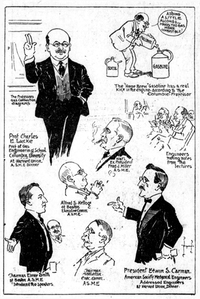 |
Taking into account what Professor Lucke reports, the thirteen or more carburetors used by the various Model T versions would have functioned normally with alcohol fuel, without any modification, but with some "manipulation." And what manipulation would have been necessary? The adjustments made with the air-fuel mixture and/or the ignition timing, of course. No special labeling or instructions were given because none were needed. Here's the analogy: A waiter in a restaurant says to the patron, "Yes, you can use that same spoon to stir your coffee and then use it to eat soup or ice cream. It handles both functions, and no special labeling or instruction are required for you to use the spoon in these different ways."
Accordingly, it seems that unless Hemmings or Bruce McCalley or anyone else can find any documentation from around that time period that proves a normal gasoline carburetor cannot be used with alcohol, I'd say that we have now fully and completely debunked the debunking of the carburetor issue.
 |
The 1918 edition of his book THE MODERN GASOLINE ENGINE - ITS DESIGN, CONSTRUCTION, OPERATION AND MAINTENANCE was an expanded edition to more than 1,000 pages owing to the technological information that had been developed during the First World War (1914-1917). Chapter V - the fifth chapter, beginning on page 349 - discusses liquid fuels, one of which is alcohol. Pagé writes that its use was mostly in countries other than the U.S. and Russia (they had control of their own petroleum oil). On page 355, he states that "some authorities contend that alcohol will be the fuel of the future."
On that same page, Mr. Pagé writes about reports that "the German Army automobiles are being run on a mixture of benzol and alcohol. As soon as Germany found herself cut off from outside supplies of gasoline a technical committee was appointed to find a substitute. Experiments were carries out with a 1914 Mercedes touring car equipped with an ordinary carburetor, when mixtures of alcohol and benzol were found to give satisfactory results."
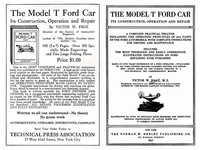 |
Although this book is quite similar to the more general book I talked about a couple of paragraphs ago, it is greatly reduced in the number of pages and content (this had only about 290 pages compared to over 1,000 pages). Yet, on page 62, Mr. Pagé describes The Ford Carburetion System with much of the same verbiage contained in the larger volume. "As the power obtained from the gas engine depends upon the combustion of fuel in the cylinders, it is evident that if the gas supplied does not have the proper proportions of elements to insure rapid combustion the efficiency of the engine will be low. When a gas engine is used as a stationary installation it is possible to use ordinary illuminating or natural gas for fuel, but when this prime mover is applied to automobile or marine service it is evident that considerable difficulty would be experienced in carrying enough compressed coal gas to supply the engine for even a very short trip. Fortunately, the development of the internal combustion motor was not delayed by the lack of suitable fuel. Engineers were familiar with properties of certain liquids which gave off vapors that could be mixed with air to form an explosive gas which burned very well in the engine cylinders. A very small quantity of such liquids would suffice for very satisfactory periods of engine operation. The problem to be solved before these liquids could be applied in a practical manner was to evolve suitable apparatus for vaporizing them without waste. Among the liquids that can be combined with air and burned, gasoline is the most common and is the fuel utilized by the majority of internal combustion engines employed in self-propelled conveyances."
So, in other words, the Ford Model T was designed to be a multi-fuel vehicle. Yes, gasoline was the most common, no one is arguing that, but Ford engineers were familiar with other liquids that could do the job. What might those other liquids be? Kerosene, alcohol, and benzol of course. The fact that Henry Ford believed in "farm fuels" means that his logical choice was alcohol - or as we call it today: Ethanol.
While certain persons alive today working for Hemmings Motor News and Green Car Reports might be hard pressed to consider that the carburetors of a century ago could easily handle more than just gasoline (as they do today, by the way, because all carburetor and fuel injected vehicles can easily handle E10, E15, E20, E25, E30 and higher).
One other thing: In 1903, two high school dropouts figured out a way to fly humans through the air in controlled, powered flight. Why would anyone imagine that Henry Ford and his associates couldn't power a land-based internal combustion engine vehicle on multiple combustible fuels?
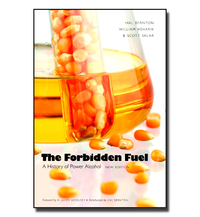 |
This book is the antithesis of what Bill Kovarik called "an argumentum ad ignorantiam" - an argument from ignorance. With this book, and then some personal contact with Bill Kovarik (as I have), the people at Hemmings and Green Car Reports, and any other disbeliever would have had actual facts in hand. They wouldn't have said, in effect, we searched the Mojave Desert high and low and found no evidence of water skiing, so water skiing must not exist on planet Earth. Daniel Strohl relied on sources that were incapable of addressing this issue because their focus of attention was not on alternative fuels.
Let me give you an example of this point: One of the other books I have on my shelves is THE FORD CENTURY - FORD MOTOR COMPANY AND THE INNOVATIONS THAT SHAPED THE WORLD, by Russ Banham. This is a big, glossy book, suitable for a coffee table. The book covers Henry's childhood, his racing experiences, his vehicles, lots and lots of stuff. The text includes the Fordson Tractor. We know from Hemmings' article that the Fordson Tractor was designed to be a multi-fuel vehicle. But in this book, there is no mention of the Fordson Tractor being a multi-fuel vehicle...in fact, it doesn't even mention that the vehicle ran on gasoline. Now this is a book, that on the cover of it are the words "The Innovations That Shaped The World," but it fails to mention that this breakthrough vehicle that helped bring agriculture into the modern age was capable of running on multiple fuels. So, if someone was doing a report for middle school, let's say, and they relied on this book as the source material, the student would have to conclude - if asked - that the Fordson Tractor was a not "flex fuel" vehicle because surely Russ Banham would have written it in the book.
On page 10 of THE FORBIDDEN FUEL is the statement: "Henry Ford supported the 'farmer's fuel' by equipping his early Model T engines with adjustable carburetors to run on alcohol." Simple, yet elegant. This now brings me to the email that Bill Kovarik sent me when I told him about the Hemmings revisionist story of the Model T.
DIRECT EVIDENCE
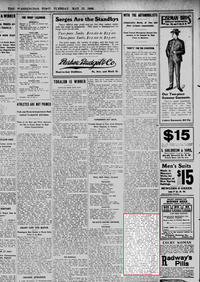 |
"WITH THE AUTOMOBILISTS - In anticipation of the passage of the act permitting the manufacture of "denatured" alcohol free, Henry Ford the Detroit automobiles manufacturer, is preparing to meet the new conditions with an automobile that will use the new fuel instead of gasoline. For several weeks past the well-appointed laboratory and experimental force of the Ford Company have been conducting exhaustive experiments to determine the best type of carburetor, or mixing valve, for vaporizing alcohol for internal combustion motors."
This same basic story appeared in the Philadelphia Inquirer, May 20, 1906 (two days before the Wash. Post story) on page 6; as well as in several other cities around the country.
This same basic story appeared in the Philadelphia Inquirer, May 20, 1906 (two days before the Wash. Post story) on page 6; as well as in several other cities around the country.
2. From Detroit Free Press, June 11, 1906, page 9:
"ALCOHOL MOTOR CARS - Big Plant to Manufacture Them is Being Planned - Will be Located in Detroit - Henry Ford Will Head The Company...Enterprise is Result of Passage of Denaturized Alcohol Bill - Ford has also made exhaustive experiments with alcohol as fuel for internal combustion motors and has been very secretive about the positive results of these experiments." This same basic story appeared in multiple cities around America.
3. From Ft. Wayne Journal-Gazette, June 17, 1906, page 20:
"FORD SAYS FREE ALCOHOL WILL REVOLUTIONIZE AMERICAN INDUSTRIES...During the past three years Ford has devoted all his leisure time, a great deal of thought and research, not only to the invention of motors that will use alcohol as fuel, but to the study of the production of alcohol itself." Same basic story appeared in multiple cities around America.
4. For several years, until a design change was made around 2008, the Ford Motor Company website included a section on Environmental Vehicles, which included Fuel Cell Vehicles, Hybrid Vehicles, and Ethanol Vehicles. The Ethanol Vehicles webpage states: "Vehicles fueled by ethanol actually use E85, a blend of 85 percent ethanol and 15 percent gasoline. Ford's interest in using ethanol as an alternative fuel goes back to the days of Henry Ford. Ford planned to use ethanol as the primary fuel for his Model T..."
This section of the Ford website was removed sometime after 2008, for reasons that are unknown to me. I realize that someone (such as the Hemmings people) might say it was removed because they discovered the information was wrong. That would be a pretty good thing to say, except that the entire Environmental Vehicles section has been removed: Fuel Cells, Hybrids, Ethanol. We know that there are and have been purpose-built Ford fuel cell vehicles; we know that there are and have been purpose-built Ford hybrid cars; and we know that there are and have been purpose-built E-85 Ford vehicles. It doesn't make sense for Ford to remove the entire Environmental Vehicles section just because they wanted to correct two sentences about the Model T - they could have simply removed the two sentences.
5. On May 30, 2006, the Louisville Courier-Journal ran a story on page D3 about Dogwood Energy, a small distillery making ethanol for fuel. The spokesman for the company told the reporter, "Using ethanol to power cars isn't new. The Model T was originally built to run on alcohol." This newspaper report fueled (pun intended) some controversy with members of the Model T Ford Club of America, who describe themselves as the world's largest Model T fan club. The group is located in Richmond, Indiana - a couple of hours north of Louisville. A club executive contacted the newspaper to check that information. The newspaper contacted Ford Motor Company and asked if the story was true. The newspaper subsequently published the following: "According to Ford spokeswoman Kristen Kinley, Henry Ford's first four-wheel engine-powered vehicle, the quadracycle, ran strictly on ethanol in 1896. When it was released in 1908, the Model T could run on either gasoline or ethanol or a combination thereof. As the market embraced petroleum, Ford stopped producing vehicles that could run on either fuel and focused on gasoline engines. But the first few years of Model Ts could run on either fuel."
A few days ago, I contacted Ms. Kinley, a long time Ford employee who rose to the position of Director, Executive and Internal Communications. Ms. Kinley confirmed that she did make that reply to the newspaper.
Coincidentally, Bruce McCalley, author of MODEL T FORD: THE CAR THAT CHANGED THE WORLD was one of the founders of this club. On February 4, 2003, the following comment and question was posted on the club's website forum page:
A few hours later, Bruce McCalley responded:
Mr. McCalley didn't reply "No." He didn't say "That's a preposterous question." He didn't say "One of the myths I debunk in my exhaustive books is the one about the Model T being multi-fuel capable." He didn't say that he had any documents from the time of the Model T introduction that refuted any notions of the Model T being designed to run on alcohol fuels. He simply said he never read anything about it, and then honestly acknowledged that it could run on anything (without any qualifying statement about air-fuel mixtures or carburetors, or separate fuel tanks). Obviously, he didn't read what Bill Kovarik and his co-authors wrote about Henry Ford or the Model T, comments made by other automotive journalists and media entities, or the dozens/hundreds of newspaper and magazine articles that talked about using alcohol in place of gasoline.
My guess is that Bruce McCalley missed the information simply because it wasn't a focus of his efforts. In the case of Daniel Strohl, his focus was on the Model T being a multi-fuel vehicle - there's no excuse for him to miss it.
Fortunately, Bill Kovarik did this research; Dave Blume did this research; Tom Quinn did this research, and I along with many others did this research.
If you would like to view the newspaper stories that I reference throughout this report please visit the Newspapers.com website. If you would like to go further, enter in your own search terms. There are hundreds of related newspaper articles from the years 1900 to 1920 that display the amount of interest, knowledge, and testing of alcohol fuels that went on in America and around the world.
What's The Reason Hemmings Published Their Story?
I hope I hear from someone(s) at Hemmings and Green Car Reports to shed light on why they would publish stories denying that the Model T was a multi-fuel car. Certainly it will be fun to see how they try to convolute the evidence if they try to stick with their positions. If they were able to provide any real proof outside of their positions being based on an "argumentum ad ignorantiam" (an argument based on the absence of information), they would have - I think.
In all likelihood, however, I may not receive any reply because they may feel it's not in their best interest to get into a squabble that lends credibility to my challenge. I did see in the comments section of the Hemmings' article a sharp reply from Daniel Strohl to a person who disagreed with his (Strohl's) conclusion. Gene (the visitor) wrote "I wonder how hard they (Hemmings) researched to come to this conclusion?" Mr. Strohl's reply was "You did read the article before commenting, didn’t you?" And then there's no more from Mr. Strohl.
Personally, I appreciate sharp responses...when they're deserved. The problem is that the reason for Gene to question Hemmings' story is because it deserved to be questioned. Daniel Strohl should have done a "byte" more research. His work didn't entitle him to react to Gene like he did, in my opinion.
While I have no proof, yet, I believe that Daniel Strohl's Hemmings story about the Model T was done as a result of some type of pressure or inducement from the oil industry. It smacks of the oil industry. It's something that the oil industry would do - they buy celebrity spokespeople; they buy academics and academic institutions; they buy politicians; they buy scientists and doctors; they buy media outlets. And by buy, I mean they provide financial inducements. The oil industry spends hundreds of millions of dollars every year to hide information, to hoodwink the public, to invent lies and gross exaggerations about the competition. The oil industry does anything and everything they can to continue selling their poison, regardless of how many people and wildlife get killed or hurt.
One of the reasons I feel so strongly about the oil industry's hand in this is another fallacious story published by Hemmings. The one I'm referring to was written by Jim O'Clair and published back in November 2012. This story was titled "Tech 101 – Ethanol in gasoline and its effects on collector cars."It attacks the use of ethanol. It gives wrong and bad information about ethanol. There is no reason for them to have done this, and here's why: For several decades, all of the European countries made extensive use of ethanol and ethanol-gasoline blends. I'm talking about countries like Great Britain, France, Germany, Italy, Spain, and Sweden - the countries that were at the forefront of industrialization and hosted so many of the fantastic automobile companies. There's names like Rolls-Royce, Bentley, Rover, Jaguar, Austin Healey, Mercedes-Benz, BMW, Audi, Volkswagen, Porsche, Renault, Citreon, Lamborgini, Ferrari, Alfa Romeo, SEAT, Hispano-Suiza, Volvo, and SAAB.
If you take a look at the monthly Hemmings magazine (and now the "cars for sale" section of their website), it's full of these cars - remember, this is how I found my 1956 Bentley S1 thirty five years ago. What I didn't know when I bought the Bentley was that it may very well have run on Cleveland Discol power alcohol or KoolMotor power alcohol (the two major UK brands owned by Standard Oil and Cities Service, respectively) for some or all of the 28 years that it was driving the roads in England. When I picked up the car at the docks in California, it was not in perfect condition - but then I didn't buy it in perfect condition. However, when I turned the key the car started and I immediately drove it many miles away to my home. The Bentley was my primary personal vehicle for the next 20+ years. The point is that if my car might have been powered by ethanol then the same would be true for literally thousands and thousands of European vehicles manufactured between the years 1900 and 1970 that must have been sold through Hemmings. The bottom line is that if ethanol is so bad for internal combustion engines, where are all the thousands of reports complaining about the damage. And if ethanol was so damaging, then why did Standard Oil, ESSO, Cities Service and other leading oil/gasoline companies sell this power alcohol fuel in Europe as being cleaner, safer, more powerful, higher MPG, and less expensive than ethanol-free gasoline?
In early December 2017, I wrote to Jim O'Clair about this, and I posted some comments on the Hemmings website. My comments shook them up (I don't know how else to explain it) so badly that they removed my comments and then a few days later closed the comments section for that article completely, so you can't see any of the comments that had been posted. I think Hemmings should have taken my comments to heart (after confirming the information) and then remove the article or added the true facts to counter the egregious misinformation about ethanol. The only reason I could think of for their actions was because of pressure put upon them by the oil industry to bad mouth ethanol. As I said, the oil industry is no stranger to lies, exaggerations, immoral and illegal tactics, and bribery.
It was from this event that I felt I should publish my own full length story about the marketing of ethanol-gasoline blends in Great Britain during the years from the 1920's to the mid-1970's. I published "THE HYPOCRISY OF BIG OIL and API" on December 20, 2017, and then gave a live presentation of it at the 2018 National Ethanol Conference in San Antonio, Texas in February 2018.
This brings me to the "bonus round," where I respond to the stupid claim made by Hemmings Motor News that they debunked the claim that John D. Rockefeller supported Prohibition in the U.S. from 1920 through 1933 for the primary purpose of hurting the alcohol fuel industry.
Prohibition, A Rockefeller Marketing Tactic
In his poorly researched article about the Model T that I've been discussing, Daniel Strohl refers to another Hemmings' story that he wrote, this one about John D. Rockefeller, founder of Standard Oil, and the 18th Amendment to the Constitution (often called "Prohibition" or the "Volstead Act"). He sets the tone of the article as being nothing much more than a crank conspiracy theory. This story is titled "Fact Check: Rockefeller didn’t pursue Prohibition to ensure ethanol’s demise as a fuel." It was published one week after the publication of his Model T story, and it also relies on "argumentum ad ignorantiam" to make its case.
Let me say this about conspiracies: Conspiracy theory doesn't necessarily mean that something is an off-the-wall hypothesis. There are conspiracy conjectures, and there are conspiracy facts. Courts all over the country, indeed all over the world, deal with cases every day that involve "conspiracies," and they are often proven to exist. Also, the word "theory" has two uses: It can mean a hunch or speculation, and it can also mean a comprehensive explanation (as in the "theory of gravity" - gravity exists, it's not a hunch or crazy hypothesis).
Mr. Strohl says that he debunked the myth that John Rockefeller used the Temperance Movement to get Prohibition enacted in order to kill ethanol as a fuel competitor. He did no such thing. What Daniel Strohl did do was to avoid reality and the facts related to John Rockefeller's entire career.
Mr. Strohl tells us that Rockefeller was a teetotaler and temperance advocate, and then acknowledges that Rockefeller contributed millions of dollars to the movement, which was then used to buy congressional support to pass the Volstead Act (some people refer to this as bribery). I concur with these two facts, and it's nice to see that Daniel got at least two facts correct. It's at this point he goes astray and tries to paint a picture of John Rockefeller as a kindly old retired businessman who only spreads goodness throughout the land (sort of like a real life Ebenzer Scrooge after his great awakening).
Mr. Strohl writes that Henry Ford "worked alongside Rockefeller with the Anti-Saloon League," and he provides a hyperlink to another story to apparently verify the notion that Hank and Jack were two old buddies. I clicked on the link expecting to see a photo of them marching arm-in-arm down some boulevard in a protest demonstration against the sins of demon-rum. However, nothing could be further from the truth. There are no photos of them together, nor are there any reports of them working alongside each other. I'm not sure what Rockefeller thought of Ford, but Ford was definitely not a fan of the richest man in the world. Moreover, Ford was able to distinguish between the value of industrial alcohol and the "evils" of alcohol as a beverage.
In 1906, prior to the passage of the Free Alcohol Act, Henry Ford spoke about alcohol fuel and the predatory nature of Standard Oil in a newspaper interview. He praised alcohol as a coming boon to rural and urban industries. Then, addressing the issue of long term alcohol fuel availability, Ford said: "No immense plant is necessary - no costly machinery. It is not even necessary to manufacture it (alcohol fuel) on a large scale. Every farmer can afford to make enough for his own individual use...And he can make it as he does butter - cheaper, considering his leisure at certain seasons, than can a factory competitor. There can never be a monopoly of the alcohol industry. To control the output of the sale of this product, the Standard Oil Trust would have to own every farm in the Unites States, obviously impossible." (The Daily Standard, June 22, 1906, page 3)
John D. Rockefeller engaged in questionable business practices throughout his business career. Some were nothing more than hard-nosed marketing tactics, some were legal but immoral, and some were illegal. In the 1870's, Rockefeller's shenanigans first came to the national public's attention with his railroad price fixing. By the time Ida Tarbell's book "THE HISTORY OF STANDARD OIL' was published in 1904, Rockefeller had been well known for his underhanded schemes (in 1880, the New York World called Standard Oil "the most cruel, impudent, pitiless, and grasping monopoly that ever fastened upon a country"). Tarbell's book documented the company's espionage, price wars, heavy-handed marketing tactics, and courtroom evasions.
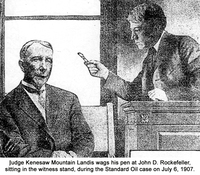 |
Although new oil discoveries in the western U.S. would cause the price of gasoline to fall back below the price of alcohol fuel, alcohol was still priced close enough to be a problem.
The First World War presented a new problem for gasoline producers, especially Standard Oil and its "baby Standards" (the newly formed companies that resulted from Standard Oil's conviction of violating the Sherman Anti-Trust Law in 1911). The Germans were winning the air war in Europe, with planes fueled with alcohol-gasoline blends, proving the blends' superiority over straight gasoline. And the war pushed the need for bigger, faster internal combustion engine vehicles with high compression engines. Gasoline caused engine knock, which in turn limited the production and consumer acceptance of modern cars and trucks. The only known solution at that time was to use alcohol or alcohol-gasoline blends. As Henry Ford said ten years before, "To control the output of the sale of this product, the Standard Oil Trust would have to own every farm in the United States, obviously impossible."
What to do? What to do about alcohol?
In a September 1916 newspaper interview, a reporter asked Henry Ford if Standard Oil had interfered with the development and progress of alcohol as a fuel in the years since the passage of the Free Alcohol Act. Ford responded: "Sure, certain people have seen to that. Such a fuel would put gasoline out of business."
The reporter then adds, "But just now, stimulated by foreign war, by the inability of manufacturers to import dyes and other chemicals, immense progress has been made in America in industrial chemistry. A substitute for gasoline was made in New Jersey, and the story is that Standard Oil investigated it, bought it up, and suppressed it. This may be pure fiction." (The Topeka Daily Capital, Sept. 21, 1916, page 4)
Indeed, this specific story about Standard suppressing an alternative to alcohol (and their own gasoline products) might have been nothing but rumor. However, it is true that Standard Oil had been working on ways to overcome alcohol and engine knock - it was either unsuccessful or too expensive, or both. I know this because shortly after the start of Prohibition, after the General Motors team of scientists invented a gasoline product that quieted engine knock, GM combined their patents with some patents owned by Standard Oil and Dupont Chemical to create the leaded gasoline product that dominated the world for more than 60 years.
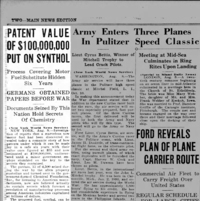 |
But let's go back to the period between WWI and GM's discovery that tetraethyl lead could mitigate engine knock...Standard Oil needed something, they needed to do something. If it's not possible to buy up all the the farms in America, a nationwide ban on alcohol could be just the ticket to get rid of the competition, or at least to give Standard's scientists the time to create their own solution. Was something like this too big of for John Rockefeller to pull off? No, he had an enormous amount of money and political power. And just because he was now in his 70's, he was still vigorous and involved, despite being "retired" - he lived long enough to almost see the start of the next world war. In any event, Rockefeller never had to point a gun himself, or carry a bag of money, or literally twist anyone's arm. He had people for that. And Rockefeller still enjoyed the power and prestige of being the world's richest man. It had only been a couple of years before Prohibition that he became America's first billionaire, back in the days when being a billionaire wasn't so pedestrian. He had plenty of life left in him. And in case you don't know, Standard Oil didn't need John D to collude with the Nazis during WWII, and Standard was convicted again (in 1947) for their part in the Street Car Conspiracy. As I said earlier, there are conspiracy conjectures, and there are conspiracy facts.
The last point that Daniel Strohl tries to make is that even if the Rockefeller sponsorship of Prohibition was the stimulus to get the law enacted it didn't matter because the specific wording of the 18th Amendment still allows for the production of alcohol as a fuel. This is an entirely disingenuous position because it ignores the reality of Standard Oil's financial and political strength, and what it would take for an alternative fuel to succeed without Rockefeller/Standard Oil blessing and support. In the years before the Supreme Court's 1911 ruling that Standard Oil must be broken up, Standard Oil controlled about 90% of the petroleum oil business in America, which meant they also had a significant impact on the retail fuel business that consisted of just an unsophisticated hodge-podge of livery stables, hardware shops, and pharmacies. Furthermore, at that time any commercial production of alcohol for fuel would have been made by the distilleries that produced drinking alcohol. If you can shut down these distilleries from making alcohol for what was their primary business, then there would be no supply of alcohol for use as fuel. In Britain, the big commercial effort to use "power alcohol" (ethanol-gasoline blends) was made possible because the alcohol came from scotch whisky distillers in Scotland - this is the business model that would have worked in America until such time that that product demand allowed dedicated alcohol-fuel distilleries to be built.
After the break-up of Standard Oil, John Rockefeller still owned or controlled a sizable stake in the 34 separate, (mostly non-competing) companies. Many of these companies owned or controlled the growing business of new well-defined service stations. Rockefeller could and did continue to have a heavy hand on their affairs. When General Motors invented leaded gasoline and combined with Standard Oil and Dupont Chemical to market the fuel, the patents on leaded gasoline (now called Ethyl Anti-Knock Gasoline) gave Rockefeller and Standard what they always wanted: virtually exclusive control of the world's engine fuel business. It didn't matter if small distilleries could produce alcohol fuel, distribution of the fuel was controlled by the "baby Standards" and other petroleum oil companies who also weren't in a rush to give up access to their retail outlets.
Daniel Strohl concludes his article with the sentence "... it’s almost certain that Rockefeller had no ulterior motives regarding ethanol as a fuel source."
I say that you have to be deaf, dumb, blind, or an oil industry employee of some kind to not recognize that Rockefeller's intention was to destroy the alcohol (ethanol) fuel industry.
1 - William Kissam Vanderbilt II was a motor racing enthusiast, yachtsman, and member of the prestigious American family. He competed in a race outside of Paris, France on May 15, 1902. The race featured only race cars powered by alcohol fuel.
2 - As an example, the Victoria Daily Times ran a story on page 17 of their May 1, 1920 edition that was titled "TO MAKE GASOLINE FROM MOLASSES." But they weren't making gasoline from the molasses that would have been used for rum, they were making alcohol (fuel). It's impossible, except through magic, to turm molasses into gasoline. The use of the word gasoline was just a generic way to get the message across about an engine fuel.
3 - The engine fuel derived from hemp is ethanol.
* If the doubt is based upon a diagnosed clinical psychosis then you will probably not be convinced.
** The text of the article in THE POWER WAGON publication is printed as "1006 engines." It's not clear if they meant 1,006 different engines or 1906 model year engines. I take it to be a topographical error and that the author/publisher meant model year 1906 engines. Either way the result is the same: any carburetor could have worked with alcohol or gasoline.
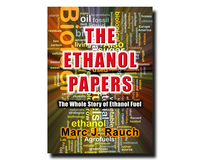 |
If you like to know more about ethanol fuel, LOTS MORE, read my 641-page book "THE ETHANOL PAPERS." It's available online for FREE by CLICKING HERE.
For some additional insight on the development of leaded gasoline read The Rise & Fall of General Motors and the Subjugation of the Industrialized World .
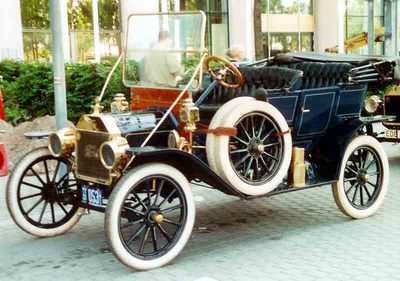

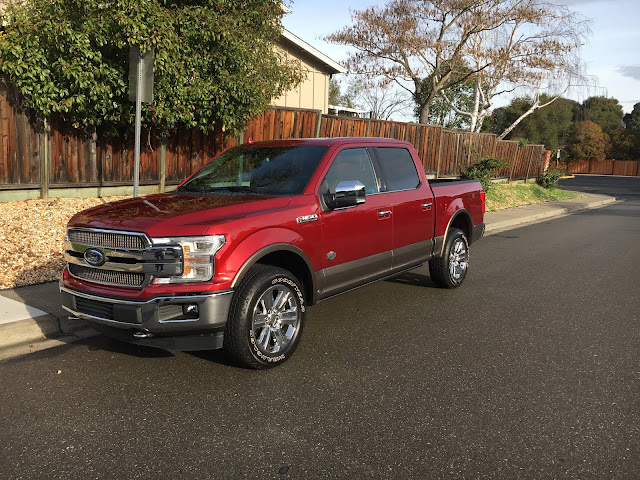
Comments